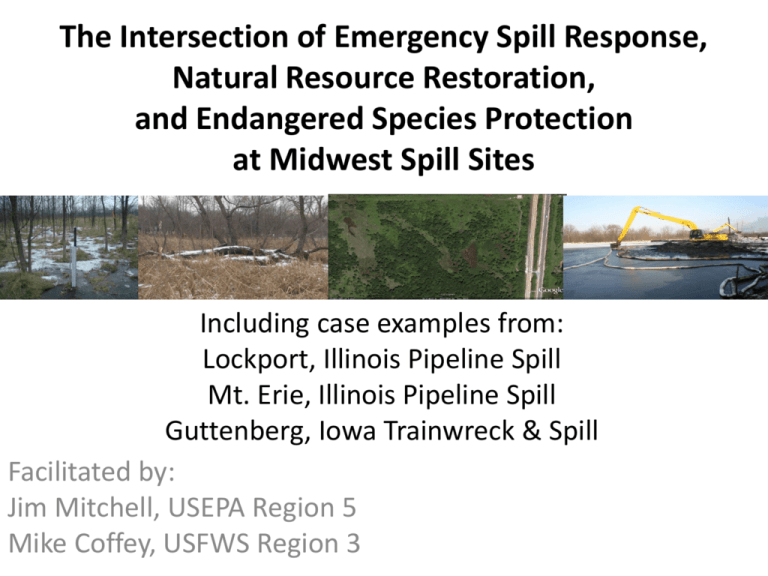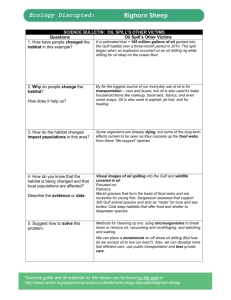ESA & NRDAR in Spill Response for USEPA R5
advertisement

The Intersection of Emergency Spill Response, Natural Resource Restoration, and Endangered Species Protection at Midwest Spill Sites Including case examples from: Lockport, Illinois Pipeline Spill Mt. Erie, Illinois Pipeline Spill Guttenberg, Iowa Trainwreck & Spill Facilitated by: Jim Mitchell, USEPA Region 5 Mike Coffey, USFWS Region 3 Background • Lockport, IL pipeline spill Dec. 14, 2010 500 barrels crude oil Ditch to wetlands 3.5 acres of oiled marsh Trenches, vac trucks, soil removal Hine’s emerald dragonfly Background • Mt. Erie, IL pipeline spill Aug. 10, 2008 5,000 barrels crude oil Slope to bottomland forest 7.1 acres of oiled sloughs Vac trucks, soil removal Indiana bat Background • Guttenberg, IA spill Jul. 9, 2008 3,800 gallons diesel fuel Railroad grade to river Absorbent booms & pads Mussel bed Emergency Spill Response (OPA & CWA) Migratory Bird Treat Act (MBTA) Pollution Response Fund Agreements PRFA Rescue of oiled wildlife Rehab of oiled wildlife Release of clean wildlife Protection of downstream resources = Resources at Risk (RAR) Shoreline Clean Up and Assessment Teams (SCAT) Minimize response impacts = Resource Advisors (RE-AD) Not a PRFA activity Directed by Trustees Not Incident Commanders Natural Resource Damage Assessment and Restoration (NRDAR) Endangered Species Act Consultation (ESA) The remaining parts of this presentation will be about the interplay between emergency spill response, ESA and NRDAR. http://www.fws.gov/endangered/ http://restoration.doi.gov/Default.aspx U.S. Fish and Wildlife Service Region 3 Ecological Services: Endangered Species Program Environmental Contaminants Program Incident Command System Endangered Species Act (ESA) • • • • • • • 16 U.S.C. 1531 et seq. Section 9 prohibitions and use of term “take” Section 7 Federal agency coordination Section 10 non-Federal agency coordination Section 7 regulations are in 50 C.F.R. 402 Includes provisions for emergency consultations In 2001, Memorandum of Agreement signed for emergency coordination on spills sites and for contingency planning http://www.epa.gov/Region7/cleanup/superfund/pdf/ricpannex_5.pdf Endangered Species Act (ESA) Section 7 Process for the response not for the oiling – Analysis to determine whether the response activities will cause take of federally listed species – Develop measures to avoid take during the response – If take will still occur, develop measures to minimize the number of organisms affected – After the emergency response, action agency completes a biological assessment with estimate of numbers – USFWS will then reply with a biological opinion that includes an incidental take statement which documents the performance of the measures used to minimize take – Lessons learned and incorporate avoidance measures into Regional, Area, and SubArea contingency plans Endangered Species Act (ESA) • federally listed Critical Habitat: – Like for species, pieces of the landscape are afforded legal protection – Primary constituent elements (PCE) are described – Analysis to determine whether the PCEs are adversely modified – Incorporate into the Section 7 process if adverse modification is likely to occur Endangered Species Act (ESA) • Section 10 non-Federal agency process – Analysis to determine whether the response activities will cause take – Develop measures to avoid take during the action – If take will still occur, develop measures to minimize the number of organisms affected – Complete a Habitat Conservation Plan, NEPA, and then a permit is issued – No provisions for emergency consultation – Federal agency discretion over State or RP led responses Triggers for Concern • Extirpation from part of the species range • Large numbers of organisms loss by a single action • Other large scale naturally occurring problems or human activities that affect the whole species population • Use of terms “Jeopardy” or Extinction Primer on Populations • Federally listed endangered species are on the edge of extinction, reduction in scale and fragmentation of species range • Some species hyper-vulnerable to spills or other perturbations because they exist in only one or several places and their numbers are now extremely low • Once too the population size is too low (functionally extinct), there is the option to bring in for captive breeding at zoos and aquariums Genetics: Interbreeding Drift Hine’s emerald dragonfly Indiana bat Disease: White nose syndrome Primer on Species Biology • • • • Species range, use county distribution Suitable habitat present, occupied or not Pathway from the action to the organisms Is the magnitude of the stress along the pathway sufficient to rise above the thresholds of harm or harassment • Life history traits help mitigate the stressor – – – – – Breeding season: finding nests, mates Reproduction: when, where, how many Winter season: migration, hibernation Foraging habits Habitat use Indiana Bat Summer Habitat Maternity colonies may be under loose bark or in snag cavities up to end of August Lockport Spill Site Hine’s emerald dragonfly Minimize summer use by adults foraging over oiled habitats Protect downstream resources by preventing flow into species habitats (and the river) white: pumped none found Green: pumped found blue: not pumped yet Quick Summary of Responsibilities USEPA USFWS Notify Trustees of spill incident including USFWS & NOAA for listed species. Respond or otherwise make staff available to spill incident. Answer question whether listed species or critical habitat affected by response ops. Answer question whether listed species or critical habitat affected by response ops. Inform response of measures to minimize take. Develop measures to minimize take. FOSC signs initiation package & requests consultation Biologist replies with consultation document and incidental take statement Lessons learned used to revise response plans. Lessons learned used to revise response plans. http://www.fws.gov/contaminants/FWS_OSCP_05/fwscontingencyappendices/ O-EndangeredSpecies/MOATrainingManualVersion02.pdf Natural Resource Damages • • • • 42 U.S.C. 9601 et seq. for CERCLA 33 U.S.C. 2791 et seq. for OPA 33 U.S.C. 1251 et seq. for CWA authorizes recovery of damages for injuries • 43 C.F.R. 11 for CERCLA • 15 C.F.R. 990 for OPA • describes the assessment and restoration processes Natural Resource Damages - Goals • Goal: Make the public whole • Objective #1: Rehabilitation the natural resources affected by exposure to the oil or hazardous substance and from impacts related to the response or remediation back to the condition that existed prior to the incident = primary restoration • Objective #2: Replace the interim or permanent loss of human uses and ecological services = compensatory restoration • Objective #3: Recover past assessment costs and future administrative costs The Natural Resource Damage Assessment (NRDA) is directed by the Natural Resource Trustees not by the FOSC, but there is the need to coordinate safety and access. The Trustees have the option to collect field data for ephemeral conditions in advance of an assessment plan. The response data collection plans may provide the needed data and information on the ephemeral conditions and the vice versa may occur. Natural Resource Damages - Terms • Trustees: Federal agencies, States, Tribes • Baseline: Pre-incident condition • Natural resources: Water (sediment), Geologic (soil), Biologic • Injury: health affects, mortality • Damages: value of injury, or cost to restore • Restoration: rehabilitation, replacement, habitat enhancement, population augmentation • Human use of natural resources • Ecological services flow from the natural resources • Valuation: willingness to pay, monetary value • In kind: similar natural resource Graphical Representation Baseline Event Time Graphical Representation Baseline Natural Recovery Event Time Graphical Representation Baseline Primary Restoration Event Time Graphical Representation Compensatory Restoration Baseline Lost Ecological Services and Human Uses Event Time Graphical Representation Compensatory Restoration Baseline Lost Services Primary Restoration Natural Recovery Event Time Natural Resource Damage Assessment • PreAssessment Screen • Assessment – Injury determination – Injury quantification (Habitat Equivalency Analysis-HEA) – Damage quantification • Report of Assessment or • Damage Assessment and Restoration Plan Habitat Equivalency Analysis (HEA) http://www.nova.edu/ocean/visual_hea/ Natural Resource Damage Settlement • Cooperative assessments and/or negotiations using results of damage assessments or evaluations • Interesting use of Admin Order for Lockport spill • Consent decree for natural resource damages In kind action by the Responsible Party Cash equivalent for action by the Trustees • Department of the Interior Revolving Fund • Prepare a Restoration Plan and NEPA • Implement the Plan • Monitor performance of restoration actions • Certify as complete Not actual site photos Examples of proposed activities Mt. Erie, IL Restoration Guttenberg, IA Restoration Not actual site photos Examples of proposed activities Lockport, IL Restoration Challenges & Discussions Questions Thank you for your participation in the discussions Jim Mitchell Health Physicist/On-Scene Coordinator USEPA Region 5 Emergency Response Branch 77 W. Jackson Blvd Chicago IL 60604 Office (312) 353-9537 Mike Coffey Contaminants Biologist USFWS Region 3 Greater Illinois and Iowa Ecological Services Field Office 1511 47th Avenue Moline, IL 61265 Office (309) 757-5800 x206






